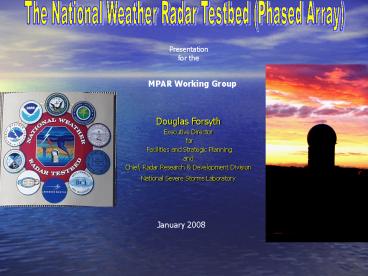The National Weather Radar Testbed (Phased Array) - PowerPoint PPT Presentation
1 / 11
Title:
The National Weather Radar Testbed (Phased Array)
Description:
Title: PowerPoint Presentation Author: doug.forsyth Last modified by: weadon Created Date: 8/21/2003 3:20:24 PM Document presentation format: On-screen Show – PowerPoint PPT presentation
Number of Views:207
Avg rating:3.0/5.0
Title: The National Weather Radar Testbed (Phased Array)
1
The National Weather Radar Testbed (Phased Array)
Presentation for the
MPAR Working Group
Douglas Forsyth Executive Director for
Facilities and Strategic Planning and Chief,
Radar Research Development Division National
Severe Storms Laboratory
January 2008
2
What is the difference between a Phased Array and
Conventional Radar?
3
Conventional radar is White
PAR is Blue
4
NWRT Milestones
May 2006
May 2004
August 2007
Sept 2003
EP upgraded Matrix PC 150 times faster (Dual 3
GHz Processors with 10 Gb Backbone) w/ new
12 terabyte RAID
Environmental Processor upgraded to a Matrix
PC w/ new 7 terabyte RAID
NWRT became operational
Completed Engineering checkout phase
May 2004 - present
Winter 2006 - Spring 2007
- Data collection for Research
(Limited data 2005 2006, poor storm seasons)
User Interface improved along with addition of
internet power control systems
5
Planned Hardware, Software, and Engineering
Upgrades Research
- Modify RTC to Support Adaptive Scanning
- Improve data quality Ground Clutter Filtering,
Range and Velocity Dealiasing, Calibration - Improved display of fast scan data
- Improved decision aids for fast scan data
- Build Dual Polarized Sub-array
Uninterruptible Power Source for the NWRT
Activate Monopulse Ports
Instrument receiver ports - OU NSF Proposal
Correct Digital Receiver Problem Allow PRT
Changes
6
Visualization
Geowall Visualization Lab
3-D Image May 29, 2004 Tornado Using Unidatas
Integrated Data Viewer and KTLX Level II data
7
Weather Aircraft Demos
- 2008
- Weather See Slides Aircraft Target ID
-
Tracking - 2009
- Weather Fast Scan Aircraft - Monopulse
- Dual Pol Tracking
- (If Available)
8
2008 NWRT PAR Spring Program
- Objectives
- Collect PAR data with scanning strategies
designed to support an assessment of the impact
of spatial and temporal sampling on the depiction
of storm processes and severe storm algorithm
performance - Attain feedback from forecasters on benefits and
challenges of diagnosing storm severity with PAR
data - Facilitate collaborative experiments
- Possibilities Study of convective initiation
and storm evolution - using rapid-update
refractivity fields from the PAR - Spaced Antenna Interferometry Experiment
- Multi-pattern Measurements for Calibration and
Sidelobe Reduction with the NWRT
9
2008 NWRT PAR Research Activities
- Quantitative comparisons of the evolution of
low-altitude circulations sampled by NWRT PAR,
KTLX, and TDWR - Investigate physical processes responsible for
the multi-scale circulations observed on 9 May
2007 (book-end vorticy, mesocyclones, tornado
vortex signatures) - Begin detailed analysis of 29 May 2004 tornadic
supercell - Begin development of circulation detection
algorithms
10
Continue Building the MPAR Business Case
- Objectives
- Continue building the MPAR business case by
proactively interacting with MPAR stakeholders to
envision and define their operational
deficiencies - Investigate how MPAR technology may mitigate
identified deficiencies and ultimately benefit
society - Methodology
- ? Personal interviews with NWS forecasters and
broadcast meteorologists in the Oklahoma City and
Tulsa markets - ? Analysis of transcribed interviews
11
THANK YOU
http//www.nssl.noaa.gov































